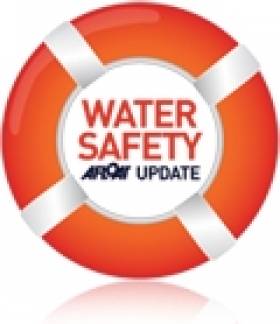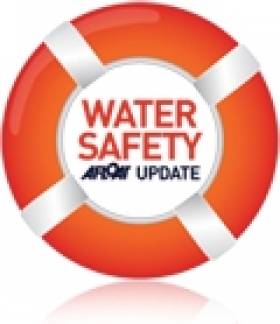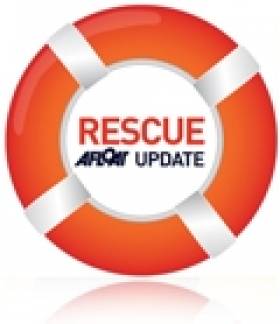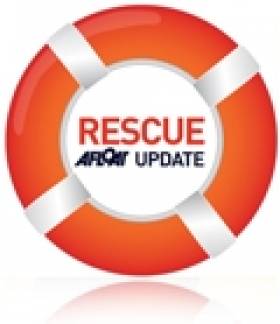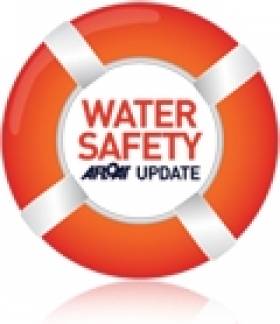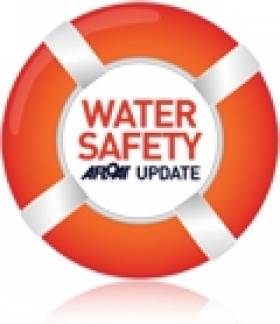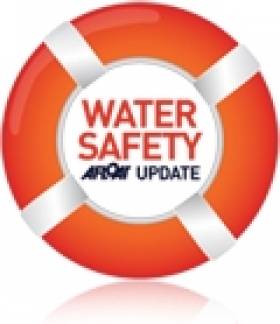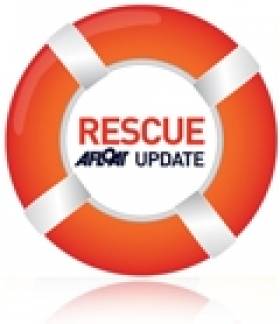Displaying items by tag: water safety
Water Safety Warnings Repeated After Man Caught By Wave In Howth
#WaterSafety - The public has been reminded yet again to stay away from the water's edge as the country continues to be battered by huge waves and storm-force winds after a man was injured on Howth's East Pier this afternoon (6 January).
As TheJournal.ie reports, the man was caught by a wave while walking along the upper portion of the North Dublin pier and thrown some 10 feet to the lower section, injuring his ankle in the fall.
The man has ventured onto the wave-lashed pier despite widespread warnings to the public from the Irish Coast Guard and Irish Water Safety to keep a good distance from the water during this latest orange alert weather warning from Met Éireann.
Coastguard chiefs have reiterated last week's appeal by Irish Water Safety for people to stay away from waterside areas until the current series of storms and high tides has passed.
Last week Waterways Ireland also warned of the dangers posed by rising tides in inland harbours and waterside areas as flooding persists in various spots nationwide.
Bundoran RNLI Urges Safety Over The Christmas Break
#Safety - Bundoran RNLI is among those urging water users to exercise common sense and safety over the current holiday period as persistent stormy weather makes sea conditions treacherous around the Irish coast.
With water hobby gifts like surfboards, bodyboards and kayaks a certainty under the tree on the 25th, the RNLI advises that all usual safety checks should be performed before heading out into the water.
If you are using equipment for the first time, make sure you know how to operate it correctly and most of all take a sensible approach when using this equipment in the water.
Check the weather forecast, check the conditions of the beach or water areas you are in and if you are unsure, seek the advice of a local surf school or coastguard who will be happy to advise you of any imminent or hidden dangers.
Bundoran RNLI lifeboat operations manager Tony McGowan adds: "We want people to enjoy the holidays and any new sporting gifts they receive for Christmas but of course we also want people to be safe and come back in one piece if they venture into the water.
"The lifeboat will as usual be on standby 24/7 over the holiday period and will be ready to launch if requested."
As the end of the year draws close, all of the crew of Bundoran RNLI wish to thank each and every supporter who has contributed to the charity this year for their generous donations.
Volunteer lifeboat press officer Shane Smyth says: "It’s been a busy year for our fundraising teams with big events like the annual Dinner Dance, the Soapbox Race, the Station to Station Challenge and of course the Boat Push.
"Thanks to all of our supporters and our fundraisers who work quietly in the background. Your help to keep us running is very much appreciated. We’d like to wish you all a very happy Christmas and a happy and safe 2014."
Tickets are now on sale for the annual dinner dance which takes place at the Great Northern Hotel on Friday 31 January 2014 with entertainment from Derek Ryan.
Irish Water Safety Issues Christmas Survival Guide
#irishwatersafety – The Christmas season is a time when thousands of people around the country must take extra care when taking part in sponsored swims in support of the many charitable causes. Thousands more are at risk when taking walks by rivers, lakes and shorelines and even more are lulled into a false sense of security when visiting relatives living close to water hazards such as slurry pits, exposed drains and canals. Irish Water Safety has compiled a Christmas survival guide to staying safe around water at Christmas time.
Christmas and New Year Charity Swims:
Get in, Get out, warm up.
Christmas day charity swimmers occasionally take chances beyond what is acceptably safe, finding themselves left without sufficient strength to climb out of the water due to the cold.
Cold winter waters can cause "cold shock" and hypothermia can set in within minutes, overwhelming the fittest of swimmers. If sea conditions deteriorate then the charity swim should be cancelled. If you see a person in difficulties do not attempt a rescue for which you are not trained. Make use of any nearby rescue equipment such as a ringbuoy and in the event of an emergency call the emergency services at 112. No alcohol should be taken before the swim.
People organising these swims on Christmas Day, St. Stephen's Day or New Year's Day should ensure that they provide comprehensive details of each event to the Irish Coast Guard and local Gardai.
Each event should have a Safety Officer appointed, who will advise those concerned on safety and have the ultimate responsibility for making decisions in relation to the swim being on or off on the day.
If the seas are rough and weather deteriorates, they should defer the event to a more suitable day without question - do not take a chance on running the event.
Many participants will not have swum since the summer and the temperature of the water has now dropped considerably. It is a fallacy that alcohol will keep you warm when entering the water; in fact it has the reverse effect and could kill you. Irish Water Safety strongly recommends that no alcohol be taken either before the swim or immediately after the swim and also remind people that they may be in breach of the drink driving laws when driving to or from the event.
Cold water can cause cold shock and hypothermia in minutes, because the temperature of the water at this time of year will be below 50°F/10°C.
Ensure that you have safe access and egress with appropriate shallow shelving or ladders as appropriate. Elderly people should be mindful that steps leading into the water might be dangerous due to the increased growth of algae in wintertime. Organisers should ensure that slipways or steps have been cleaned of slime, weed and algae. Contact your Local Authority to have this completed.
Swimmers' remaining in the water for extended periods in a gesture of bravado is not acceptable. The message is "Get In, Get Out and Warm Up".
General Water Safety over Christmas and New Year:
Supervise children at all times, but especially if you are on holidays abroad this Christmas.
Never swim alone in a pool unprotected by lifeguards; ensure that there are lifeguards on duty within the pool area.
Do not engage in any water-based activities after the consumption of alcohol.
Alcohol should not be consumed before your water safety activity
Always wear a lifejacket when boating or participating in other aquatic sports.
In a Marine Emergency call 999 or 112 and ask for the Coast Guard, always call early.
Avoid cold shock and hypothermia on Christmas and New Year Charity Swims. Throw a handful of water down the back of your neck before you take your plunge to help avoid cold shock.
Stay away from the edge when fishing from rocks or on the banks of rivers, or lakes always wearing a lifejacket.
Flooding:
Avoid flooded areas as fast running water and submerged hazards pose a serious threat.
Rising waters, fast flowing currents and dangerous hidden hazards are all present with rising and receding flood waters. Move to higher ground immediately using alternative routes to avoid becoming trapped and respect the power of fast rising waters and the dangers of exposed drains and submerged objects. No driver or pedestrian should take a chance passing through flooded roadways. Parents should caution children that floodwaters hide the true depth and that manhole covers may be open and that small streams when swollen are very fast and deeper than normal. Knowing what to do when surprised by localised flash flooding will help avoid property damage, injury and drowning.
What should I do when I hear a Flood Warning?
Listen to the national and local radio for met eireann updates. Click on http://www.flooding.ie/en/ for further information.
Check on neighbours particularly if they are elderly, infirmed or families with young children.
Move your vehicles to higher ground.
Move animal stock to higher ground.
Check your small craft to ensure they are well secured or moored, consider taking them up on a trailer for safety.
Make sure you have warm clothes, food, drink, a torch and radio.
Block doorways and airbricks with sandbags or plastic bags filled with earth. Floodgate products will work effectively also.
Switch off gas and electricity supplies if flooding is imminent.
Check the time of High Water in the Newspaper or at www.irishtides.ie
Personal Safety
Avoid flood waters at all times.
Carry a mobile phone at all times in case you need to call for help - call 112 in emergency.
Wear suitable protective clothing & a Lifejacket in on or around water.
Never try to swim through fast flowing water.
Never put your feet down if swept away.
Flooding on roads will be deeper at dips and around bridges.
Stay away from sea and flood defences.
When walking or driving, be aware of manhole covers and gratings that may have been moved due to the heavy flow of water.
Take care when using electric appliances in damp or flood conditions.
Remember that during the hours of darkness the dangers are multiplied.
Tides:
As you walk shorelines, keep a close eye on new moon tidal advances and carry your mobile in case you are cut off.
On December 17th and January 16th, a new moon will increase the range of our tides causing higher and lower tides, however there is still a risk between these periods where large areas of beach and rocks which we normally don't see will be exposed. Many people enjoy exploring these new areas of beach and in particular enjoy picking shellfish to eat. The risk of becoming stranded as the tide advances can quickly leave people cut off from the shore which is why people should carry their mobile and call 112 if required. All those boating, surfing, diving or swimming should be aware of tidal streams around our coast over the Christmas weekend and at all times.
Ice:
Should we experience a repeat of the icy conditions of 2010 and 2011, there are dangers specific to frozen canals, rivers and lakes. Children are especially at risk as they are attracted to playing on ice. Constant supervision is the key to keeping children off the ice as there is no such thing as safe ice. Also at risk are individuals who attempt to rescue others fallen through ice. Ice-related drownings often occur when the rescuer gets into difficulty attempting to rescue another person or a family pet. Playing or fishing on the frozen edges of a river, lake or canal is perilous as ice can be quite thick in one area yet dangerously thin in others.
Ice Safety Tips to stay out of danger
Rescuing another person from ice can be dangerous. The safest way to perform a rescue is from shore. Use your Mobile.
Call for help at 112 and ask for the Emergency Services. Give your precise location, the number of people in difficulty and any conspicuous building or landmark nearby.
Check if you can reach the person using a Ringbuoy and rope, long pole, items of clothing or branch from shore - if so, lie down and extend the pole to the person.
If you cannot reach them then pass out something that will float e.g. a ringbuoy, empty water proof container e.g. oil, milk containers.
Instruct the casualty to keep still to maintain their heat and energy;
If you go onto ice, wear a lifejacket and carry a long pole or branch to test the ice in front of you. Bring something to reach or throw to the person (e.g. pole, weighted rope, line or tree branch).
When near the break, lie down to distribute your weight and slowly crawl toward the hole.
Remaining low, extend or throw your emergency rescue device (pole, rope, line or branch) to the person.
Have the person kick while you pull them out.
Move the person to a safe position on shore or where you are sure the ice is thick.
All casualties should be taken to hospital even if they appear to be unaffected by their ordeal as they will be suffering from hypothermia.
Never go out on ice alone and especially at night.
Irish Water Safety's National Awards Honour 37 Rescuers
#watersafety – Thirty-seven rescuers from twenty-two dramatic near-death incidents will receive recognition at Irish Water Safety's National Awards Ceremony at City Hall on Tuesday 19th November 2014, from 3pm to 5pm. Thirty-six lives were saved from drowning through the brave actions of these rescuers.
Mr Fergus O'Dowd TD Minister of State at the Department of Communications, Energy & Natural Resources and Environment, Community & Local Government will present the "SEIKO Just in Time Rescue Award" to these rescuers in appreciation for saving so many lives.
"Tragically an average of 140 drownings occur in Ireland every year," commented Minister O'Dowd, "and although that's 140 too many, the figure would be even higher but for the dramatic efforts of these individuals who saved others from drowning and the ongoing work of volunteers teaching swimming and rescue skills. Last year, the 147 drownings in Ireland were higher than the annual average, reason enough to highlight the work of Irish Water Safety Volunteers and their partners in the public and private sector in educating more people on how best to enjoy our wonderful aquatic facilities more safely. Complacency around aquatic environments is simply not an option", he added."
"The tragic drownings during this summer's warm weather brought home the need for constant vigilance around water. During the hot spell, twelve people drowned in two weeks and in July alone, Lifeguards trained and assessed by Irish Water Safety, rescued 559 people from drowning."
"I appeal to all adults to make themselves more aware of the dangers in, on and around water", continued Minister O'Dowd. "It only takes seconds for tragedy to strike and this can so easily be avoided if people take responsibility for their own safety by learning about the hazards. I ask that people encourage friends and family to read Irish Water Safety's guidelines at www.iws.ie so that they don't become a drowning statistic."
"Drownings often happen quickly and silently with 80% of drownings occurring close to the victim's home. The range of aquatic activities is extremely varied yet what is tragically constant each year is the gender most at risk - males - tragically reflected in the fact that of the 147 drownings last year, 113 were male and 34 female. An alarming 47% of accidental drownings occurred in the 30-59 year age group clearly demonstrating that regardless of age, one is never too old to learn how to stay safe around water."
Long-Service Awards will also be presented, recognising 670 years of personal service of 29 Irish Water Safety volunteers from around the country for teaching swimming, rescue and water survival skills.
Flares No Longer Needed To Signal Distress Says RYA
#Flares - Distress flares have outlived their usefulness in an age of modern water safety technology, says the Royal Yachting Association - which is urging British authorities to drop the requirement for flares on yachts larger than 13.7 metres.
On her Yachting World blog, Elaine Bunting highlights quotes from the RYA's cruising manager Stuart Carruthers who argues that the need for flares is negated by "EPIRBs, personal locator beacons, and VHF DSC that will do the job automatically".
He adds: "If you are not carrying another electronic device [aside from flares] then you'd be barking mad, because that's the way the management of search and rescue has gone."
Carruthers also points out that an omnidirectional laser flare works out as better value than an offshore flare pack, and performs a better job of helping to pinpoint your location in a rescue effort.
The RYA is now pushing for the UK's Maritime and Coastguard Agency (MCA) to review its safety requirements for craft over 13.7m, which make compulsory the carriage of parachute flares - which are illegal if the operator has not undergone training, though there is currently no training available for yachtsmen.
Yachting World has much more on the story HERE.
Water Safety Warns Stay Safe, Smart & Sober Near Water
#watersafety – Water-related tragedies can happen in seconds and in the wake of 147 drownings last year, Irish Water Safety is drawing attention to the dangers that will put people's lives at risk this coming Bank Holiday weekend.
Wet, windy weather with spot-flooding will make aquatic activities and family bank holiday walks near water hazardous meaning people need to note the following basic measures that if heeded, will avoid needless tragedies this weekend.
A danger foreseen is a danger avoided...
Walkers should remain alert and stay well away from the edge of ordinarily familiar waterside pathways due to the risk of riverbanks crumbling away. These walks will be all the more hazardous due to windy with conditions and likely spot flooding. Please carry your mobile phone and remain in the company of others.
Alcohol should be avoided before or during any aquatic activity. Over 30% of drowning victims had consumed alcohol therefore it is best left until after your activity to celebrate this bank holiday weekend.
Those on water should ensure that their family and friends wear a PFD (Personal Flotation Device) at all times.
Supervise children at all times - it only takes seconds for tragedy to strike an unsupervised child. On wet weekend days, prompt children in your care to learn water safety in a fun way at www.aquaattack.ie.
Anglers will be at risk and foreign nationals in particular should be extremely vigilant as the Atlantic coastline is dramatically different to that experienced on the relatively calmer Baltic Sea. Never fish without your PFD and stay well away from the edge, particularly in windy conditions.
Remember your lifeline in an emergency is 112 therefore carry a mobile phone and ask for the coastguard at the first sign of difficulties.
Innovative Lifesaving Devices Vie For Design Award
#WaterSafety - A lifejacket that turns into a wetsuit and a special harness that keeps lifejacket wearers upright in the water are in contention for a top innovation prize, as Yachting Monthly reports.
The Hydros personal flotation device (PFD), by Irish designer Kieran Nomroyle, and the TeamO Back Pull lifejacket harness are both in the running for the James Dyson Award - and the £30,000 (€37,800) cheque that comes with it - which is set to be announced on 7 November.
Design graduate Nomroyle explains that his invention was inspired by his role as a lifeguard and medic with the Irish Army Reserve, and he developed Hydros as a solution to the problem of hypothermia for his final year college project.
The TeamO, meanwhile, was developed by solo sailor Oscar Mead from Southampton and attempts to fix a "design flaw" in tethered lifejackets that causes wearers to be dragged through the water face-down.
Yachting Monthly has much more on the story HERE.
Annual UK Drowning Figures Revealed Ahead of RoSPA Water Safety Seminar
#watersafety – The number of people accidentally drowning in the UK has dropped by nearly nine per cent in a year to 371 deaths in 2012, latest figures reveal.
More than half of deaths from accidents or natural causes continued to be in inland waters, such as rivers, lakes and reservoirs(203), while drowning at the coast or in a harbour, dock, marina or port accounted for a third (124), according to new data from the National Water Safety Forum (NWSF).
The NWSF's Water Incident Database (WAID), which breaks down drownings by activity, age and location type, reveals that more than a fifth of fatalities (84) were in the 50-65 age group, many while involved in activities such as sub aqua diving, swimming and angling.
Meanwhile, the under-19s accounted for 12 per cent of deaths (43), of which more than half were teenagers aged 15 to 19 (25) who predominantly got into difficulties in rivers or at the coast or beach. In the youngest age bracket of four and under, seven children drowned, two while in a bath.
Figures are revealed ahead of the National Water Safety Seminar, hosted by The Royal Society for the Prevention of Accidents (RoSPA), which takes place at The Lowry, Salford Quays, on Thursday (October 17).
David Walker, a member of the NWSF and RoSPA's leisure safety manager, said: "While the figures for 2012 are encouraging, we mustn't get complacent, especially given the prolonged heatwave we had this year.
"There's much more that could be done to save lives and improve water safety. That's why the main focus of the National Water Safety Seminar will be to create a consensus for a national drowning prevention strategy in order to further reduce the number of deaths."
Professionals covering sea, beach, inland, swimming pool and watersports safety including from the Royal Life Saving Society UK, the Royal National Lifeboat Institution, and the Amateur Swimming Association will use the seminar to discuss how best to tackle key issues, such as increasing the number of schoolchildren who can swim the minimum requirement of 25m.
In 2011, 407 people drowned from accidents or natural causes in the UK, with 219 of these (54 per cent) at inland waters. In this year, water-related deaths for children and young people up to the age of 19 reached 47 and nearly half of these - 22 deaths - were in the 15 to 19 age group, and predominantly in a river or lake.
Video: RNLI Gives Top Help Tips For Kayakers
#WaterSafety - The RNLI has posted the above video outlining what kayakers can do to call for help if they get into difficulty on the water.
Taking a whistle along for the trip is one sensible idea, as is ensuring a means of longer-range communication such as a VHF radio or a mobile phone in a dry case.
Carrying a flare may also prove handy, and there's always that old standby if other water users are within earshot - shouting as loud as you can to attract attention.
Avoid Drownings for the Remainder of the Summer
#watersafety – Irish Water Safety is appealing to the public to stay safe for the remainder of the summer. John Leech, CEO of IWS is pleading with the public to be careful when you go swimming for the remainder of the summer. We have already lost too many people this year to drowning. The forecast is promising for the remainder of the traditional bathing season. Please follow the following simple steps to keep you and your family safe:
Swim at Lifeguarded waterways - http://www.iws.ie/bathing-areas-page.html;
If there is no Lifeguarded waterway nearby then swim at a recognized, traditional bathing area.
Swim within your depth - stay within your depth;
Supervise children at all times until you are in your car driving home;
Use local knowledge to determine local hazards and safest areas to swim;
Ensure that ringbuoys are present where you swim;
Make sure that the edges are shallow shelving so that you can safely and easily enter and exit the water;
Only drink alcohol after your aquatic activity has ended. Stay Away From The Edge after you consume alcohol.
Never bring inflatable toys or floating killers to beaches, lakes or rivers
There was a full moon on Wednesday so beware of rip currents as they will be strong over the coming days.
The majority of drownings, 62%, occur inland where river and lake beds can be difficult to see and therefore extremely difficult to determine if you are swimming within your depth. The onset of cramp, combined with the panicked realisation that you are out of your depth can have tragic consequences and be compounded further by the muscle cooling effect of longer periods in open water. Bear in mind that in a recent analysis on drowning over the last 25 years we discovered that 32% of drowning victims had consumed alcohol so stay away from water when you have been drinking.
If you see someone in difficulty, these simple steps may save a life:
Shout to the casualty and encourage them to shore. This may orientate them just enough.
Reach out with a long object such a branch or a piece of clothing but do not enter the water yourself.
Throw a ringbuoy or any floating object and call 112 for the coast guard.


























